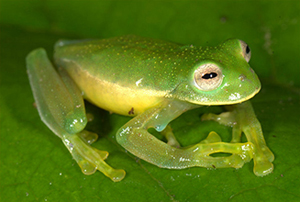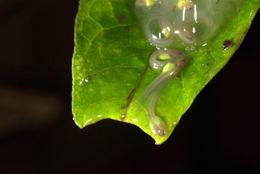Glass frog discovered in Peru at Wayqecha is the world’s 7,000th amphibian species!
October 21, 2012
 The Amazon Conservation Association (ACA) is pleased to announce that an ACA-funded research team discovered the 7,000th amphibian species in the world (according to AmphibiaWeb at UC-Berkeley). There are currently 8,680 existing species of amphibians, and 0ver one-third are listed as globally threatened or extinct, making this find especially significant. Frogs are dying out worldwide due to habitat destruction, climate change, and – increasingly – the spread of chytrid, a parasitic fungus.
The Amazon Conservation Association (ACA) is pleased to announce that an ACA-funded research team discovered the 7,000th amphibian species in the world (according to AmphibiaWeb at UC-Berkeley). There are currently 8,680 existing species of amphibians, and 0ver one-third are listed as globally threatened or extinct, making this find especially significant. Frogs are dying out worldwide due to habitat destruction, climate change, and – increasingly – the spread of chytrid, a parasitic fungus.
The team found the previously undescribed frog in Peru’s tropical Andes at ACA’s Wayqecha Cloud Forest Biological Station, located in the buffer zone of Manu National Park, a UNESCO-designated World Heritage Site and Biosphere Reserve. This unique region, where the eastern slopes of the tropical Andes meet the Amazonian lowlands, fosters an incredible variety of species, and is a center of global amphibian diversity.

The new glass frog, described as Centrolene sabini, is particularly intriguing for researchers due to its high sensitivity to the chytrid fungus; at least two species in the area have already been lost and are considered extinct. Ongoing research on Centrolene sabini will focus on bacteria found on the frog’s skin, which seems to provide protection from the deadly chytrid fungus and could eventually offer a preventive treatment for free-ranging frogs – a goal elusive to scientists thus far.
 The team was led by Wayqecha’s research coordinator Alessandro Catenazzi (pictured here) of San Francisco State University. Catenazzi has studied frog populations in and around the Wayqecha Biological Station for over a decade, documenting the decline in frog diversity and populations. A 40 percent loss of frog diversity over the last decade has been documented in the cloud forests around Wayqecha, with aquatic-breeding frogs experiencing the greatest decline. While following patterns of biodiversity loss worldwide, in this instance the decline of glass frogs is likely caused by the recent expansion of the chytrid fungus into the area.
The team was led by Wayqecha’s research coordinator Alessandro Catenazzi (pictured here) of San Francisco State University. Catenazzi has studied frog populations in and around the Wayqecha Biological Station for over a decade, documenting the decline in frog diversity and populations. A 40 percent loss of frog diversity over the last decade has been documented in the cloud forests around Wayqecha, with aquatic-breeding frogs experiencing the greatest decline. While following patterns of biodiversity loss worldwide, in this instance the decline of glass frogs is likely caused by the recent expansion of the chytrid fungus into the area.
The new frog is named after Andrew Sabin, president of the Andrew Sabin Family Foundation, and lifelong conservationist, philanthropist, and amphibian enthusiast and advocate. (Photos by Alessandro Catenazzi)

